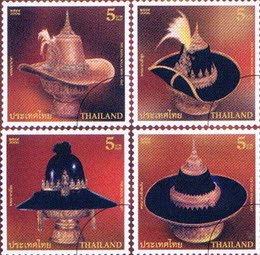A Brief Look at the Origin of the Postage Stamp by Jimmy Cox
In 1837 Sir Rowland Hill, after having completed exhaustive studies of the postal service then in effect, made public his revolutionary idea, the stamp. This was, reduced to its simplest expression, merely the fact that it cost no more to deliver a letter a hundred miles than it did to deliver one a few city blocks. After three years of pushing his claims the idea was officially adopted and along with it the means of collecting postage in advance - the postage stamp.
Some people claim that the postage stamp was an "invention" but such would not seem to be the case, for stamps had been used for collecting revenues for many years previous to the introduction of their use to collect postage. Indeed, the Stamp Tax Act brought about the "Boston Tea Party" and, eventually, the American Revolution. "Taxation without representation", the ringing words that called a new nation to arms, sprang from the use of revenue stamps.
The world's first postage stamp, Great Britain's famous "Penny Black", did present somewhat of an innovation in that it was gummed on the back. This caused considerable public comment at the time for many considered the idea of slobbering over the back of Queen Victoria's face an affront not to be countenanced. Simultaneously with issuing of the first adhesive stamp, Great Britain also issued the world's first government-stamped envelope and letter sheet. This, the famous "Mulready Envelope", caused an even greater public expression than did the adhesive stamp. The Mulready Envelope and its counterpart, the letter sheet, resembled nothing even closely approximating the modern stamped envelopes that are so common today. William Mulready, one of the foremost artists of the time, chose as his design an allegorical figure of Britannia dispatching messages to the entire world.
The design, now recognized as one of great beauty and meaning, brought forth a flood of derision in the press, and entrepreneurs, quick to see a good thing, quickly made up envelopes caricaturing the Mulready design. Commenting on the new stamps and envelopes the Ingoldsby Legends contained the following ditty:
"The manager rings, And the prompter springs To his side in a jiffy, and with him he brings A set of those odd-looking envelope things, Where Britannia (who seems to be crucified) flings To her right and her left funny people with wings Amongst Elephants, Quakers, and Catabaw Kings; And a taper and wax, And small Queen's heads, in packs, Which, when notes are too big, you're to stick on their backs".
The "Queen's heads", of course, were the adhesive stamps.
This furor and ridicule might well have ruined Row-land Hill's whole idea and, in fact, did result in the withdrawing of the Mulready Envelope. But the need for a better postal system was so pressing, and Hill's plan of universal postage proved so completely to satisfy the demand, that the stamp idea stuck and became the basis of every postal system of the world today. For a few cents, or whatever the rate may be, anyone in any civilized country in the world may send a letter a few city blocks or many thousands of miles.
Rowland Hill's universal postage idea worked well within the limits of each country where it was adopted. However, difficulties were encountered when mail was to be transported over international boundaries. This involved the negotiation of separate postal treaties between nations - a cumbersome arrangement which caused no end of confusion and, not infrequently, the stoppage of mail delivery when treaties had expired or could not be negotiated.
Dr. Heinrich von Stephan, the first postmaster of the German Empire, labored strenuously for the establishment of some form of an international union that would permit the flow of international mail with the same ease that existed for delivery of mail within a single country. His efforts resulted in the formation of the Universal Postal Union in 1875. All civilized nations have become members and since its foundation, the U.P.U. has insured the rapid and uninterrupted passage of mail throughout the world. The U.P.U. is one of the greatest achievements of history.
This, then, is the genesis of the postal systems as we know them today.
About the Author
Discover How To Start A Stamp Collection For Fun And Profit!
Click here for FREE online ebook!
http://www.stampforcollector.net/
Source: http://www.goarticles.com/cgi-bin/showa.cgi?C=462376
Browse » Home » » A Brief Look at the Origin of the Postage Stamp
22 December 2007
A Brief Look at the Origin of the Postage Stamp
Subscribe to:
Post Comments (Atom)
ไปรษณียากรไทย แสมป์ไทย ล่าสุด
แสตมป์ไทย แบบต่าง ๆ
- แสตมป์ 100 ปี พุทธทาส
- แสตมป์กรุงเทพฯ เมืองแฟชั่น
- แสตมป์กล้วยไม้
- แสตมป์การเขียนจดหมาย
- แสตมป์ความร่วมมือไทย - สวีเดน
- แสตมป์ความร่วมมือไทย - อิตาลี
- แสตมป์คุณทองแดง
- แสตมป์งานกาชาด
- แสตมป์ชีวิตใต้ทะเล
- แสตมป์ชุดปีใหม่
- แสตมป์ดอกกุหลาบ
- แสตมป์ที่ระลึก
- แสตมป์ที่ระลึก 100 ปี สยามสมาคมในพระบรมราชูปถัมภ์
- แสตมป์ที่ระลึก 30ปี ความสัมพันธ์ทางการทูตไทย-จีน
- แสตมป์ที่ระลึกงานแสดงตราไปรษณียากรแห่งชาติ
- แสตมป์นักษัตรประจำปี
- แสตมป์พระราชวัง
- แสตมป์พระเครื่อง
- แสตมป์วันพุทธศาสนา
- แสตมป์วันสงกรานต์
- แสตมป์วันสำคัญทางพุทธศาสนา
- แสตมป์วันสื่อสารแห่งชาติ
- แสตมป์วันเด็ก
- แสตมป์อนุรักษ์มรดกไทย
- แสตมป์เรือพระที่นั่ง
แสตมป์ไทย อดีต-ปัจจุบัน
คนคิดแปลก มองมุมต่าง
Copyright © 2009 แสตมป์ไทย | Fresh Themes Gallery | NdyTeeN. All Rights Reserved. Powered by Blogger and Distributed by Blogtemplate4u .


COMMENTS :
0 comments to “A Brief Look at the Origin of the Postage Stamp”
Post a Comment